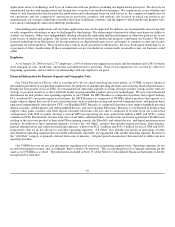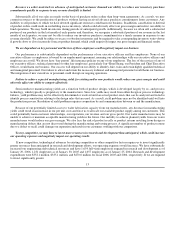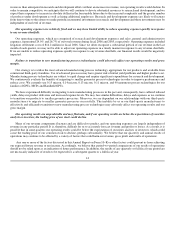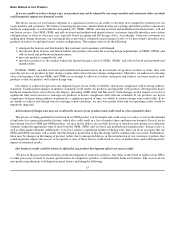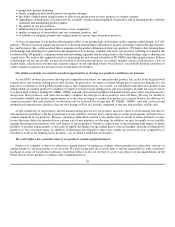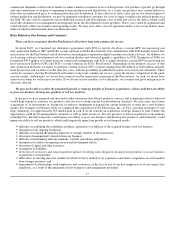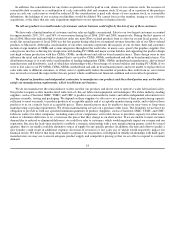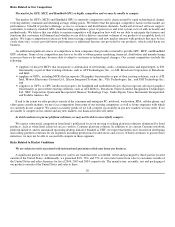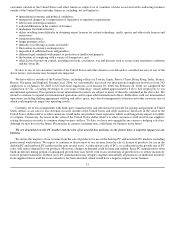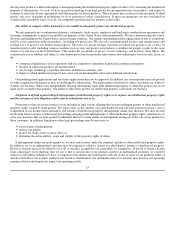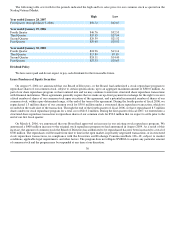NVIDIA 2006 Annual Report Download - page 26
Download and view the complete annual report
Please find page 26 of the 2006 NVIDIA annual report below. You can navigate through the pages in the report by either clicking on the pages listed below, or by using the keyword search tool below to find specific information within the annual report.
Risks Related to Our Competition
The market for GPU, MCP, and Handheld GPUs is highly competitive and we may be unable to compete.
The market for GPUs, MCPs and Handheld GPUs is intensely competitive and is characterized by rapid technological change,
evolving industry standards and declining average selling prices. We believe that the principal competitive factors in this market are
performance, breadth of product offerings, access to customers and distribution channels, backward−forward software support,
conformity to industry standard APIs, manufacturing capabilities, price of processors and total system costs of add−in boards and
motherboards. We believe that our ability to remain competitive will depend on how well we are able to anticipate the features and
functions that customers will demand and whether we are able to deliver consistent volumes of our products at acceptable levels of
quality. We expect competition to increase both from existing competitors and new market entrants with products that may be less
costly than ours, or may provide better performance or additional features not provided by our products, which could harm our
business.
An additional significant source of competition is from companies that provide or intend to provide GPU, MCP, and Handheld
GPU solutions. Some of our competitors may have or be able to obtain greater marketing, financial, distribution and manufacturing
resources than we do and may be more able to adapt to customer or technological changes. Our current competitors include the
following:
• suppliers of discrete MCPs that incorporate a combination of networking, audio, communications and input/output, or I/O,
functionality as part of their existing solutions, such as ATI Technologies, Inc., or ATI, Broadcom Corporation, or Broadcom,
and Intel;
• suppliers of GPUs, including MCPs that incorporate 3D graphics functionality as part of their existing solutions, such as ATI,
Intel, Matrox Electronics Systems Ltd., Silicon Integrated Systems, Inc., VIA Technologies, Inc., and XGI Technology Inc.;
and
• suppliers of GPUs or GPU intellectual property for handheld and embedded devices that incorporate advanced graphics
functionality as part of their existing solutions, such as ATI, Bitboys, Broadcom, Fujitsu Limited, Imagination Technologies
Ltd., NEC Corporation, Qualcomm Incorporated, Renesas Technology Corp., Seiko−Epson, Texas Instruments Incorporated,
and Toshiba America, Inc.
If and to the extent we offer products outside of the consumer and enterprise PC, notebook, workstation, PDA, cellular phone, and
video game console markets, we may face competition from some of our existing competitors as well as from companies with which
we currently do not compete. We cannot accurately predict if we will compete successfully in any new markets we may enter. If we
are unable to compete in our current and any new markets, our financial results will suffer.
As Intel continues to pursue platform solutions, we may not be able to successfully compete.
We expect substantial competition from Intel's publicized focus on moving to selling platform solutions dominated by Intel
products, such as when Intel achieved success with its Centrino platform solution. In addition to its current Centrino notebook
platform initiative, and its announced upcoming desktop initiative branded as VIIV, we expect that Intel is now focused on developing
and selling platform solutions for all segments including professional workstations and servers. If Intel continues to pursue these
initiatives, we may not be able to successfully compete in these segments.
Risks Related to Market Conditions
We are subject to risks associated with international operations which may harm our business.
A significant portion of our semiconductor wafers are manufactured, assembled, tested and packaged by third−parties located
outside of the United States. Additionally, we generated 84%, 76% and 75% of our total revenue from sales to customers outside of
the United States and other Americas for fiscal 2006, 2005 and 2004, respectively. The manufacture, assembly, test and packaging of
our products outside of the United States and sales to these
20


